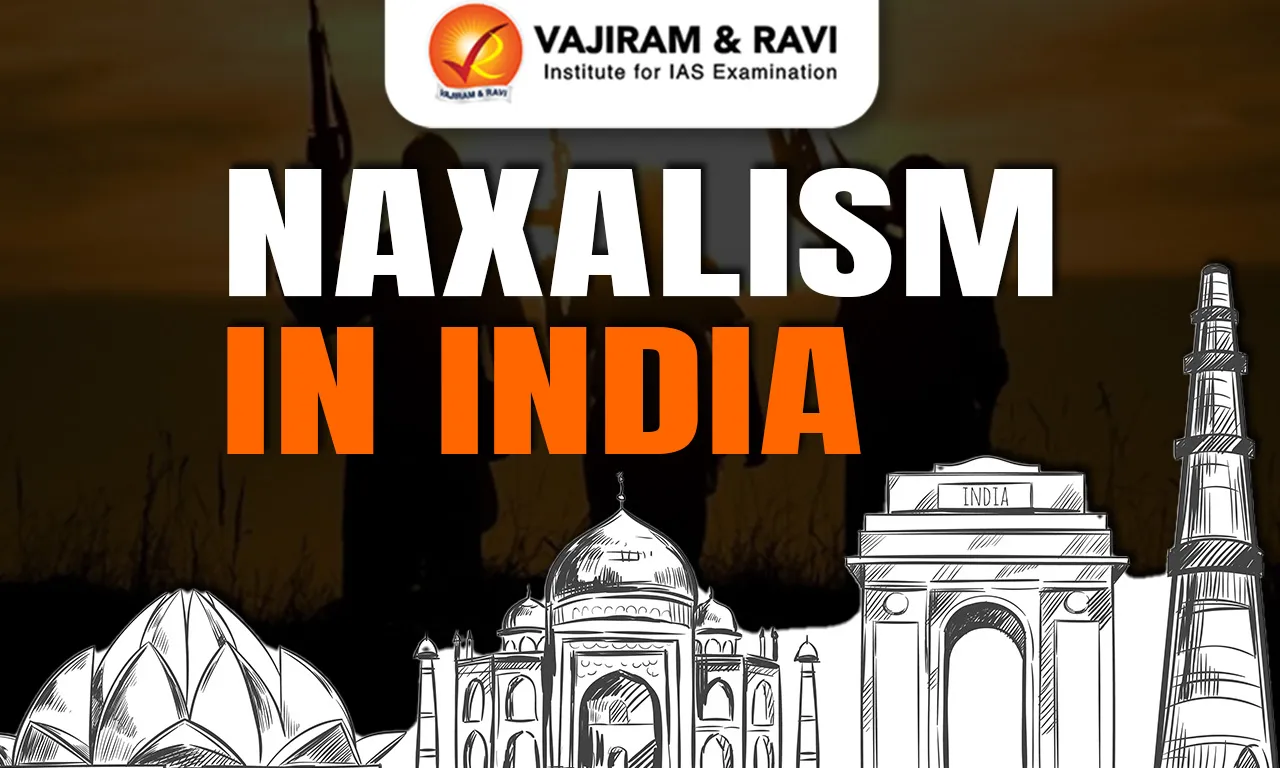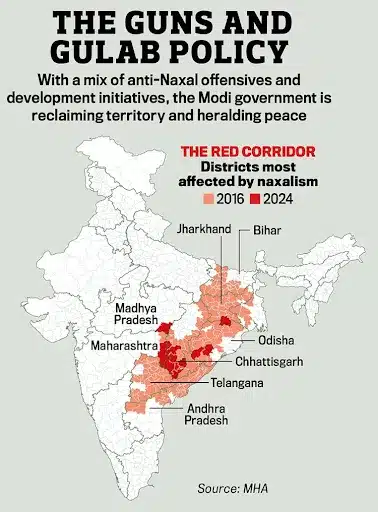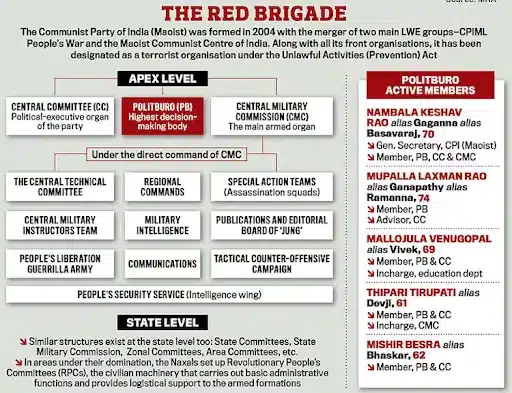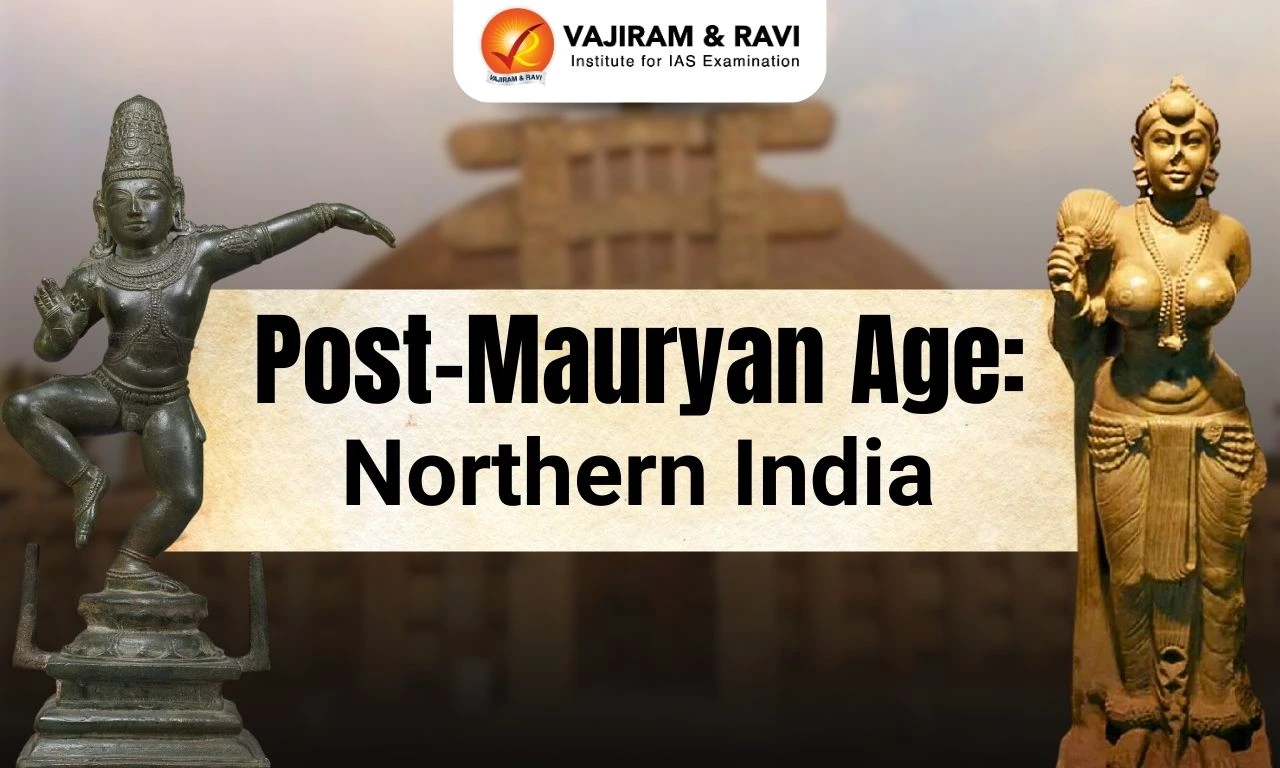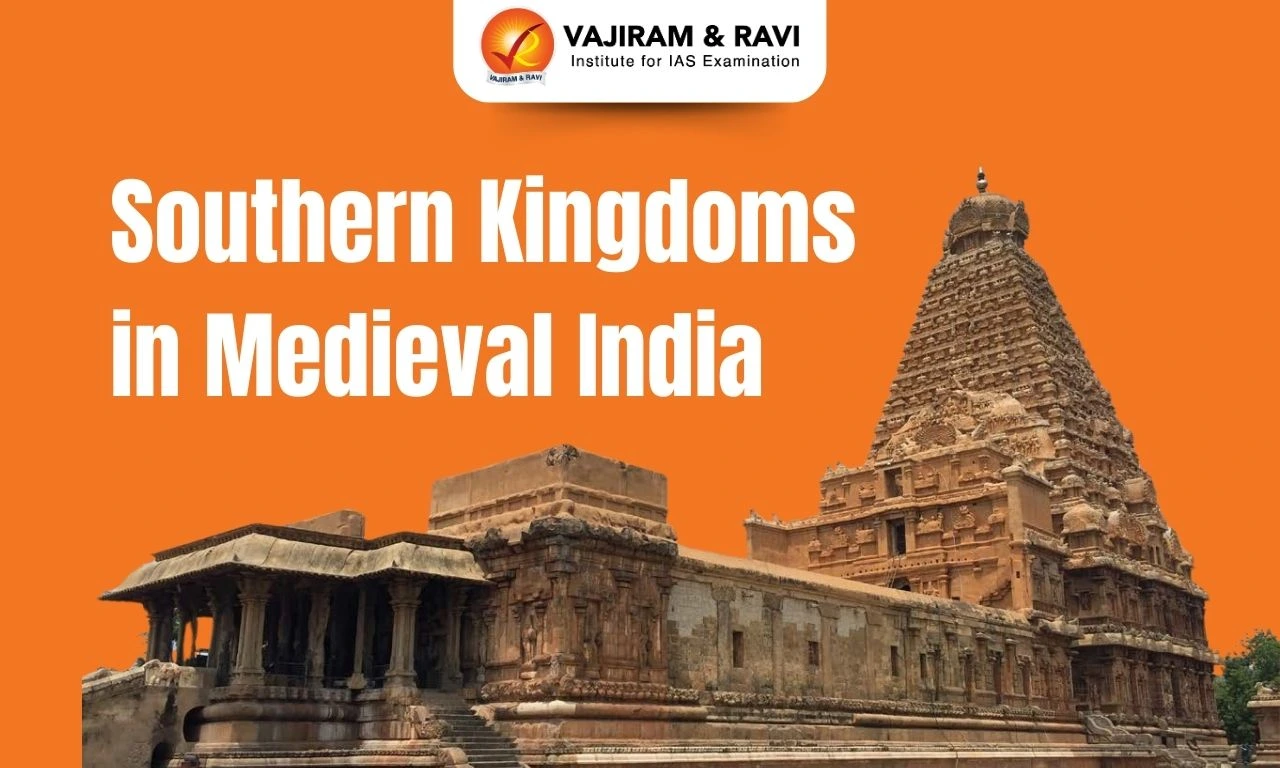Naxalism in India is a powerful reminder of the urgent need to address deep socio-economic inequalities, resolve land disputes, and uplift marginalised tribal communities. Naxalism which is also referred to as Naxal, Naxalite, or Naksalvadi, represents militant left-wing movements active across various parts of India under diverse organisational structures.
Originating in Naxalbari, a village in Darjeeling district, West Bengal, the movement began in 1967 under the leadership of Charu Majumdar, Jangal Santhal, and Kanu Sanyal. Initially localised in West Bengal, it later expanded to less-developed rural regions of Jharkhand, Chhattisgarh, Odisha, and Andhra Pradesh, primarily through underground organisations like the Communist Party of India (Maoist).
Naxalism Meaning
Naxalism refers to the militant left-wing movement in India rooted in communist ideologies. It aims to address social and economic inequalities through armed struggle. Naxalism operates under various organisational frameworks across India and remains a persistent internal security challenge.
Naxalism in India
Naxalism in India refers to the far-left Maoist insurgency that originated in Naxalbari, West Bengal, in 1967. It seeks to overthrow the state through armed rebellion, primarily operating in the "Red Corridor." Rooted in socio-economic disparities, it remains a major internal security challenge despite sustained counterinsurgency efforts.
- In 2014, 126 districts in 10 states were classified as the most affected. In early 2025, this count is down to 12, the majority being in Bastar.
History of Naxalism in India
History of Naxalism in India began in ~1967 with the Naxalbari uprising, later spreading across India. Despite government crackdowns and factional splits, it evolved into CPI (Maoist) and remains an ongoing socio-political and security challenge.
- Origins in Naxalbari Uprising (1967): The movement began with a peasant revolt in Naxalbari village, West Bengal, led by communist leaders against local landlords. The revolt protested exploitative practices and demanded land reforms.
- Formation of CPI (Marxist-Leninist) (1969): Following ideological splits within the Communist Party of India (Marxist), leaders like Charu Majumdar and Kanu Sanyal established the Communist Party of India (Marxist-Leninist) to pursue armed revolution.
- Spread to Other States (1970s): The Naxalite movement expanded beyond West Bengal to rural areas in states such as Andhra Pradesh, Bihar, Odisha, and Madhya Pradesh, gaining support among marginalised communities.
- Government Crackdown and Operation Steeplechase (1971–1972): The Indian government launched military operations to suppress Naxalite activities, resulting in the arrest and deaths of key leaders, including Charu Majumdar in 1972.
- Emergence of New Groups (1980s–1990s): Despite setbacks, factions like the People's War Group (PWG) and Maoist Communist Centre (MCC) emerged, continuing insurgent activities and advocating Maoist ideologies.
- Formation of CPI (Maoist) (2004): The PWG and MCC merged to form the Communist Party of India (Maoist), intensifying insurgency efforts and consolidating influence in the "Red Corridor."
- Government Countermeasures (2000s–Present): The Indian government has implemented security operations and development initiatives to address Naxalism, aiming to curb violence and address underlying socio-economic issues.
Phases of Naxalism in India
Phases of Naxalism in India include emergence, regrouping and expansion, and consolidation, marked by armed struggle, ideological shifts, and state responses combining force and development. The growth and evolution of Naxalism in India, commonly referred to as Left-Wing Extremism (LWE), can be categorised into three distinct phases:
Phase 1: Naxalbari and Early Struggles (1967–1974)
Phase 1 of Naxalism in India was started with the Naxalbari Uprising (1967), which crystallised after police fired on protesting peasants in Naxalbari village, Darjeeling, West Bengal, on May 25, 1967. Leaders like Charu Majumdar, Jangal Santhal, and Kanu Sanyal mobilised landless peasants to seize landlords' lands, branding them as "class enemies."
- Formation of CPI (Marxist-Leninist): Led by Charu Majumdar, the Communist Party of India (Marxist-Leninist) was established in 1969, inspired by the Communist Party of China.
- Ideology: The CPI (ML) rejected the electoral process and promoted violent revolution to achieve political goals. This was the first major instance of an armed peasant uprising post-independence.
- Post-Charu Majumdar’s Death: The party lacked credible leadership, was fragmented, and was eventually reorganised as CPI (ML) Liberation in 1974.
- Groups like CPI (ML) Satyanarayan Singh Group (SNS) and factions led by Ashim Chatterjee and Santosh Rana emerged.
- Impact of Emergency (1975): The movement faced severe repression, with around 40,000 cadres imprisoned.
Phase 2: Revival and Strategic Expansion (1980s)
Phase 2 of Naxalism in India was marked by a re-emergence in a more violent form, extending its influence from West Bengal to Bihar, Odisha, Andhra Pradesh, and Chhattisgarh, following the strategy of a protracted war.
- Formation of People’s War Group (PWG): Established in 1980 in Andhra Pradesh under Kondapalli Seetharamaiah, the PWG drew heavily from Mao Tse Tung's theory of peasant insurrection.
- Objective: To establish a "people’s government" through guerrilla warfare, converting rural areas into liberated zones before encircling cities.
- Emergence of MCC: The Maoist Communist Centre (MCC), originally formed as Dakshin Desh in 1969, also aimed to achieve a people’s government through organised armed struggle.
- Setbacks: Security operations and internal conflicts weakened the movement during this period.
Phase 3: Consolidation and Escalation (2000–Present)
Phase 3 of Naxalism in India was marked by the formation of the People’s Guerrilla Army in 2000, marking the transition to more coordinated violence. The PWG and MCC merged to form CPI (Maoist), which became the most dominant and violent LWE outfit.
- Territorial Spread: By the 2000s, Naxalism affected 233 districts in 20 states, particularly in the Dandakaranya region (Chhattisgarh, Odisha, Maharashtra, Andhra Pradesh).
- Parallel Administration: Maoists operate a parallel judiciary and government in affected areas.
- LWE activities are now confined to nine states: Chhattisgarh, Odisha, Jharkhand, Madhya Pradesh, Kerala, Maharashtra, Telangana, Andhra Pradesh, and West Bengal.
Major Naxal Attacks in India
Naxalite-Maoist insurgency has led to several significant attacks in India over the years. Notable incidents include:
- Dantewada Attack: On April 6, 2010, Maoist insurgents ambushed a convoy of the Central Reserve Police Force (CRPF) near Chintalnar village in Chhattisgarh's Dantewada district, resulting in the deaths of 76 CRPF personnel.
- Dantewada Bus Bombing: On May 17, 2010, Maoists targeted a civilian bus in Dantewada district by detonating a landmine, leading to the deaths of 31 to 44 individuals, including Special Police Officers and civilians.
- Jehanabad Jail Break: On November 13, 2005, over a thousand Maoist insurgents attacked the Jehanabad prison in Bihar, freeing more than 300 inmates, including several top Maoist leaders.
- Sukma Attack: On April 24, 2017, Maoists ambushed a CRPF convoy in Sukma district, Chhattisgarh, killing 26 personnel.
- Sukma–Bijapur Attack: On April 3, 2021, an ambush by Maoist militants in the Sukma-Bijapur border area led to the deaths of 22 security personnel and 20 insurgents.
- Indravati Forest Clash: On February 9, 2025, in Chhattisgarh's Indravati forest region, a clash between Maoist insurgents and security forces resulted in the deaths of at least 31 rebels and two police officers.
Naxalism in India Causes
Naxalism in India is caused by socio-economic inequalities, landlessness, exploitation of tribal communities, lack of development, unemployment, displacement due to mining projects, and ineffective governance in remote and marginalised regions.
- Landlessness and Agrarian Distress: Widespread landlessness among marginalised communities and failure to implement land reforms have led to agrarian distress, exploitation by landlords, and deep-rooted dissatisfaction, fueling support for the Naxalite movement.
- Exploitation of Tribal Communities: Tribal populations in central and eastern India have long faced neglect, displacement due to mining and development projects, and exploitation by forest officials and contractors, creating fertile ground for insurgent ideologies.
- Poverty and Economic Inequality: Severe poverty, lack of employment opportunities, and unequal distribution of resources in underdeveloped regions contribute to resentment against the state, making Naxal ideology appealing to the economically deprived.
- Lack of Education and Health Services: The absence of a quality education sector, healthcare, and basic infrastructure in remote and forested areas deepens alienation and mistrust toward government institutions, enabling extremist groups to gain influence and control.
- Poor Governance and Corruption: Administrative apathy, corruption at grassroots levels, and failure to deliver justice or basic entitlements push people toward Naxal groups that promise swift and alternative systems of governance.
- Displacement due to Industrialization: Unplanned industrial development and resource extraction have led to mass displacement without adequate rehabilitation, particularly affecting tribals and Dalits, intensifying their discontent and support for violent resistance.
- Police Atrocities and State Violence: Allegations of custodial torture, fake encounters, and heavy-handed operations by security forces have aggravated local grievances, reinforcing the Naxal narrative of state oppression and injustice.
Challenges in Combating Naxalism in India
Combating Naxalism in India faces challenges like difficult terrain, poor intelligence, guerrilla tactics, socio-economic grievances, legal concerns, and resource constraints, which hinder effective operations and long-term resolution of the insurgency.
- Inadequate Intelligence and Coordination: Effective counterinsurgency operations require precise intelligence. However, gathering actionable information is challenging due to the rebels' deep integration with local communities and the lack of coordination among various government agencies.
- Ambush Tactics and Guerrilla Warfare: Naxalites employ guerrilla tactics, including ambushes and hit-and-run attacks, exploiting their familiarity with the terrain to inflict casualties on security forces and then disappearing into dense forests.
- Socio-Economic Grievances: Persistent issues like poverty, landlessness, and unemployment in affected regions fuel local support for Naxalism, complicating efforts to delegitimise the insurgency without addressing these underlying problems.
- Legal and Human Rights Concerns: Operations against Naxalites must balance security objectives with human rights considerations. Allegations of excesses by security forces can erode public trust and inadvertently bolster insurgent propaganda.
- Resource Constraints: Limited manpower, equipment, and funding for security forces impede sustained operations, while Naxalites often have access to illicit funds and arms, creating an asymmetry in capabilities.
Naxalism in India Government Measures
The Indian government combats Naxalism through security operations, development programs, infrastructure expansion, improved governance, and rehabilitation policies to address both violence and the socio-economic grievances of affected communities.
- Security Operations: Major operations like Operation Steeplechase (1971) and Operation Green Hunt (2009) deployed joint forces and specialized COBRA commandos to curb Naxalite activity.
- The Greyhounds in Andhra Pradesh and the Bastariya Battalion in Chhattisgarh represent focused efforts to involve local youth, especially tribals, in counterinsurgency.
- The Unified Command (2010) was created to ensure interstate coordination among affected regions.
- Skill Development: Initiatives like the ROSHNI scheme and the establishment of ITIs in LWE-affected districts have been done to enhance employability.
- Development Measures: The Forest Rights Act (2006) empowers tribal communities, while the Civic Action Programme (CAP) builds trust between locals and forces.
- SAMADHAN Strategy: A operational strategy to fight Left Wing Extremism. The strategy emphasises:
- Smart leadership
- Aggressive strategy
- Motivation and training
- Actionable intelligence
- Dashboard-based performance metrics
- Harnessing technology
- Action plans for theatres
- No financial access for insurgents.
- Aspirational Districts Programme (ADP), launched by the Government of India in January 2018, aims to rapidly transform 112 of the most under-developed districts across the country, including those affected by Left Wing Extremism (LWE).
- Media Plans: A robust media plan counters Maoist propaganda via government messaging through various mediums, including youth exchange programs.
- GIS Mapping: This project maps financial services, schools, post offices, health facilities, roads, and security features across LWE-affected areas, facilitating data-driven decisions for development and security.
Naxalism in India UPSC PYQs
Question 1: Naxalism is a social, economic, and developmental issue manifesting as a violent internal security threat. In this context, discuss the emerging issues and suggest a multilayered strategy to tackle the menace of Naxalism. (UPSC Mains 2022)
Question 2: What are the determinants of left-wing extremism in Eastern India? What strategy should the Government of India, civil administration, and security forces adopt to counter the threat in affected areas? (UPSC Mains 2020)
Question 3: Left Wing Extremism (LWE) is showing a downward trend, but still affects many parts of the country. Briefly explain the Government of India’s approach to counter the challenges posed by LWE. (UPSC Mains 2018)
Question 4: Mob violence is emerging as a serious law and order problem in India. By giving examples, analyse the causes and consequences of such violence. (UPSC Mains 2017)
Question 5: The government’s development drives for large industries in backward areas have isolated tribal populations facing multiple displacements. With Malkangiri and Naxalbari as case studies, discuss corrective strategies needed to reintegrate affected citizens into mainstream social and economic growth. (UPSC Mains 2015)
Last updated on December, 2025
→ Check out the latest UPSC Syllabus 2026 here.
→ Join Vajiram & Ravi’s Interview Guidance Programme for expert help to crack your final UPSC stage.
→ UPSC Mains Result 2025 is now out.
→ UPSC Notification 2026 is scheduled to be released on January 14, 2026.
→ UPSC Calendar 2026 is released on 15th May, 2025.
→ The UPSC Vacancy 2025 were released 1129, out of which 979 were for UPSC CSE and remaining 150 are for UPSC IFoS.
→ UPSC Prelims 2026 will be conducted on 24th May, 2026 & UPSC Mains 2026 will be conducted on 21st August 2026.
→ The UPSC Selection Process is of 3 stages-Prelims, Mains and Interview.
→ UPSC Result 2024 is released with latest UPSC Marksheet 2024. Check Now!
→ UPSC Prelims Result 2025 is out now for the CSE held on 25 May 2025.
→ UPSC Toppers List 2024 is released now. Shakti Dubey is UPSC AIR 1 2024 Topper.
→ UPSC Prelims Question Paper 2025 and Unofficial Prelims Answer Key 2025 are available now.
→ UPSC Mains Question Paper 2025 is out for Essay, GS 1, 2, 3 & GS 4.
→ UPSC Mains Indian Language Question Paper 2025 is now out.
→ UPSC Mains Optional Question Paper 2025 is now out.
→ Also check Best IAS Coaching in Delhi
Naxalism in India FAQs
Q1. What is Naxalism in India?+
Q2. How many Naxalites are there in India?+
Q3. What is the biggest Naxal attack in India?+
Q4. What is the operation against Naxals?+
Q5. Who is the father of Naxalism in India?+



